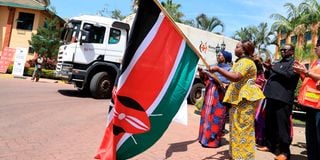Seek alternatives to ‘poorly targeted’ food support, IMF advises Kenya

Ms Dorcas Rigathi flags off relief food at the Kenya Red Cross headquarters on October 14, 2022. IMF has called on countries, including Kenya, to get ready to halt food support to millions of people facing starvation, faulting interventions the government has made to cushion starving populations as untargeted and wasteful.
What you need to know:
- IMF has called on countries, including Kenya, to get ready to halt food support to millions of people facing starvation, faulting interventions the government has made to cushion starving populations as untargeted and wasteful.
- IMF says while a four-season drought in the country has left about four million Kenyans acutely hungry and in need of aid, the government must start considering replacing the issuance of food aid to affected people with other measures.
- The IMF, however, holds that the measures are short-term, untargeted and unsustainable for countries already facing fiscal challenges.
The International Monetary Fund (IMF) has called on countries, including Kenya, to get ready to halt food support to millions of people facing starvation, faulting interventions the government has made to cushion starving populations as untargeted and wasteful.
The IMF, which also insists on a complete phase-out of fuel subsidies, says while a four-season drought in the country has left about four million Kenyans acutely hungry and in need of aid, the government must start considering replacing the issuance of food aid to affected people with other measures.
“While these measures, especially food support, may be necessary for the current emergency, they should eventually be phased out and replaced with better-targeted alternatives, ensuring that scarce resources go to those who need them most,” the IMF said in its sub-Saharan Africa (SSA) economic outlook report.
The report observes that most of the measures SSA countries have employed to arrest the high food and fuel prices, which have led to starvation, included tax cuts on food or fuel, price controls, direct government arrangements to import staples and introduction of subsidies.
The IMF, however, holds that the measures are short-term, untargeted and unsustainable for countries already facing fiscal challenges.
“In the current emergency, some of these measures may be a necessary expedient, but they should also be phased out eventually. Many programmes, like subsidies, are often expensive and poorly targeted, funnelling public funds to those with the greatest consumption rather than the greatest need, and at the expense of other critical priorities such as public investment,” it states.
“In the short-term, to alleviate immediate pressures, countries should protect the most vulnerable from rising food prices through temporary and preferably targeted fiscal measures. However, these measures can be costly and, given limited fiscal space, should be phased out gradually,” the IMF adds.
Acute food insecurity
The multilateral lender took this position, even as it noted the growing danger around SSA as 123 million face acute food insecurity, which could lead to deaths and loss of livelihoods.
It noted that Kenya now ranks among countries facing the worst starvation on the continent, with 7 per cent of the country’s population – mainly in northern Kenya – suffering hunger. This has been caused by a drought that has hit the country for four planting seasons, and which persists.
“With 123 million acutely food-insecure people across the region, rising food and energy prices mean that lives are at risk. Tackling this issue is a clear priority, but the ability to rapidly expand social safety nets is constrained in many cases, so some countries have turned to expensive and poorly targeted support measures,” the report states.
The World Food Programme (WFP) has identified the drought in the Horn of Africa as the world’s worst food emergency in 2022.
The Central Bank of Kenya says the government, on its own, cannot handle the growing problem and will require help from international bodies, such as WFP, to support the more than four million starving Kenyans.
“We should be careful about the short-term support measures. The problem is very much now. I missed a very strong statement (from the report) about the need for the international community to come in and help us deal with this problem,” said CBK Governor Patrick Njoroge.
Terming the action by the international community to support struggling nations tackle the biting food crisis as a public good, Dr Njoroge said the shorter-term issues they are facing are much more pressing.
“We need a lot of international support to deal with the famine in the northern horn, we can’t do it by ourselves,” he said.
The report by IMF also noted that international support must be stepped up to enhance food security in the region, including an immediate plan to channel food aid to the region and help scale up existing social safety nets and fast-track targeted interventions.
IMF warns that the current food security crisis could persist due to high food prices, continued drought and insecurity in some countries.
“An unprecedented four-season drought has hit Ethiopia and Kenya, eroding households’ access to food, while higher fertiliser prices are disrupting domestic food supplies for this and future harvest seasons, even for net food exporters,” the IMF says.
Among the seven East African Community states, the Democratic Republic of Congo (DRC) and South Sudan have the worst cases of starvation. DRC has about 24 million of its 92 million population facing an acute food shortage, while more than half of South Sudan’s 11-million population (5.8 million) face the same fate.
Kenya comes third with 4.3 million people facing acute food shortages, followed by Uganda at 1.8 million, Burundi’s one million and Tanzania with slightly more than 600,000 people.
Failed rain seasons
“The drought situation continues to worsen in 20 of the 23 Asal (arid and semi-arid land) counties. This is attributed to the four successive failed rain seasons. The number of people in need of humanitarian assistance currently stands at 4.35 million based on the 2022 long rains food and nutritional security assessment report,” the National Disaster Management Authority stated this month.
It flagged Garissa, Isiolo, Kajiado, Kitui, Mandera, Marsabit, Laikipia, Samburu, Tana River, Turkana and Wajir as counties in the “alarm” drought phase.
Facing the challenges of high inflation, huge public debt and constrained fiscal space, Kenya like other SSA countries, IMF observes, finds itself closer to the edge and will heavily rely on how global markets behave.
“In this regard, policymakers face the most challenging environment in years. They will need to deal with immediate socioeconomic crises as they emerge (fighting fires), while also reducing vulnerabilities to future shocks as best they can (building resilience),” the IMF states.
The IMF faults the countries for lacking adequate social protection programmes, which has made them resort to “second-best short-term policy measures”.





